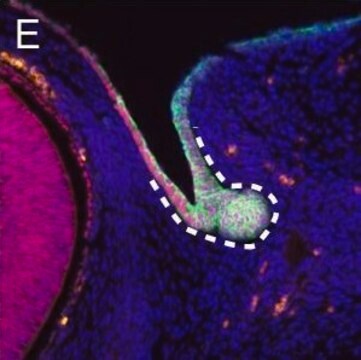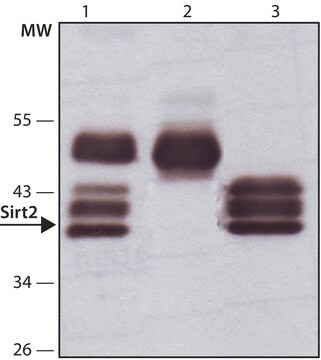ABT1383
Anti-phospho-Keratin-18 Antibody (Ser52)
from rabbit, purified by affinity chromatography
Sinonimo/i:
Keratin, type I cytoskeletal 18, Ser52-phosphorylated, Cell proliferation-inducing gene 46 protein, Ser52-phosphorylated, CK-18, Ser52-phosphorylated, Cytokeratin-18, Ser52-phosphorylated, K18, Ser52-phosphorylated, Keratin-18, Ser52-phosphorylated
About This Item
Prodotti consigliati
Origine biologica
rabbit
Livello qualitativo
Forma dell’anticorpo
affinity isolated antibody
Tipo di anticorpo
primary antibodies
Clone
polyclonal
Purificato mediante
affinity chromatography
Reattività contro le specie
human
tecniche
western blot: suitable
N° accesso NCBI
N° accesso UniProt
Condizioni di spedizione
ambient
modifica post-traduzionali bersaglio
phosphorylation (pSer52)
Informazioni sul gene
human ... KRT18(3875)
Descrizione generale
Specificità
Immunogeno
Applicazioni
Qualità
Western Blotting Analysis: A 1:5,000 dilution of this antibody detected upregulated Keratin-18 Ser52 phosphorylation in 10 µg lysate from phosphatase inhibitors Calyculin A- and Okadaic acid-treated HEK293 cells.
Descrizione del bersaglio
Altre note
Non trovi il prodotto giusto?
Prova il nostro Motore di ricerca dei prodotti.
Codice della classe di stoccaggio
12 - Non Combustible Liquids
Classe di pericolosità dell'acqua (WGK)
WGK 1
Certificati d'analisi (COA)
Cerca il Certificati d'analisi (COA) digitando il numero di lotto/batch corrispondente. I numeri di lotto o di batch sono stampati sull'etichetta dei prodotti dopo la parola ‘Lotto’ o ‘Batch’.
Possiedi già questo prodotto?
I documenti relativi ai prodotti acquistati recentemente sono disponibili nell’Archivio dei documenti.
Il team dei nostri ricercatori vanta grande esperienza in tutte le aree della ricerca quali Life Science, scienza dei materiali, sintesi chimica, cromatografia, discipline analitiche, ecc..
Contatta l'Assistenza Tecnica.








